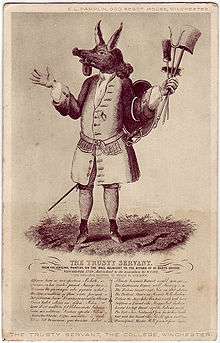Hircocervus

The hircocervus (Latin: hircus, "billy goat" + cervus, "stag") or tragelaph (Greek: τράγος, tragos, "billy goat" + έλαφος, elaphos, "stag"), also known as a goat-stag or horse-stag, was a legendary creature imagined to be half-goat, half-stag.
The creature is now best-known through The Trusty Servant painting in Winchester College, representing the ideal virtues of its alumni.
Origins
In his work De Interpretatione, Aristotle utilized the idea of a fabulous goat-stag to express the philosophical concept of something that is knowable even though it does not really exist.[1] In Plato's Republic, Socrates speaks of his own image-making as similar to that of painters who paint goat-stags, combining the features of different things together (488a).[2]
The word hircocervus first appears in the English language in a medieval manuscript dating from 1398 (now at the Bodleian Library).[1]
The Trusty Servant
A hircocervus is depicted in a wall-painting called The Trusty Servant, painted by John Hoskins in 1579.[3] It hangs outside the kitchen of Winchester College in Hampshire, England.[1] The author Arthur Cleveland Coxe described "the time-honoured Hircocervus, or picture of 'the Trusty-servant,' which hangs near the kitchen, and which emblematically sets forth those virtues in domestics, of which we Americans know nothing. It is a figure, part man, part porker, part deer, and part donkey; with a padlock on his mouth, and various other symbols in his hands and about his person, the whole signifying a most valuable character."[4]
The painting of The Trusty Servant had a didactic function: it is accompanied by allegorical verses that associate the hircocervus servant's various animal parts with distinctive virtues that the students of Winchester College were meant to follow.[5]
The Latin verses have been translated into English as:
A trusty servant's picture would you see,
This figure well survey, who'ever you be.
The porker's snout not nice in diet shows;
The padlock shut, no secret he'll disclose;
Patient, to angry lords the ass gives ear;
Swiftness on errand, the stag's feet declare;
Laden his left hand, apt to labour saith;
The coat his neatness; the open hand his faith;
Girt with his sword, his shield upon his arm,
Himself and master he'll protect from harm.[1]
- ^ Quoted in Howard Staunton, The Great Schools of England (Strahan. 1869), 61n.
In culture
Umberto Eco refers to a hircocervus in his novel The Island of the Day Before.[1]
Martin Luther uses the term "Goat-stag" (tragelaphus in his Latin) in his Theses Against the Antinomians (1540, Sixth Set) to describe "a law that does not condemn". Luther is stating that one can imagine a law from God that only instructs or teaches without threatening and condemning human sin. However, Luther claims that such a law, often sought by theologians throughout Christian history, does not actually exist.[6]
The Trusty Servant Medal
In 2014 Winchester College commissioned a medal by Old Wykehamist Anthony Smith to be awarded to staff in recognition of "Long And Loyal Service". The medal features a relief sculpture of the hircocervus, as it appears in The Trusty Servant painting.[7]
References
- 1 2 3 4 Quinion, Michael (2009). "Hircocervus". World Wide Words. Retrieved February 8, 2009.
- ↑ Plato Republic. 488a.
- ↑ Pattern Histories: The Trusty Servant accessed 29 May 2007
- ↑ Arthur Cleveland Coxe, Impressions of England. (Google Books)
- ↑ Mark Thornton Burnett, Constructing "monsters" in Shakespearean drama and early modern culture (New York: Macmillan, 2002), 139.
- ↑ Luther, Martin. Weimar Ausgabe. 39I:358.26-27; Luther, Martin. Solus Decalogus Est Aeternus: Martin Luther’s Complete Antinomian Theses and Disputations. Ed. and trans. Holger Sonntag. Latin and English ed. (Minneapolis: Lutheran Press, 2008): 375.
- ↑ "Trusty Servant Medal". Anthony Smith Sculpture. Retrieved 30 October 2016.
.jpg)